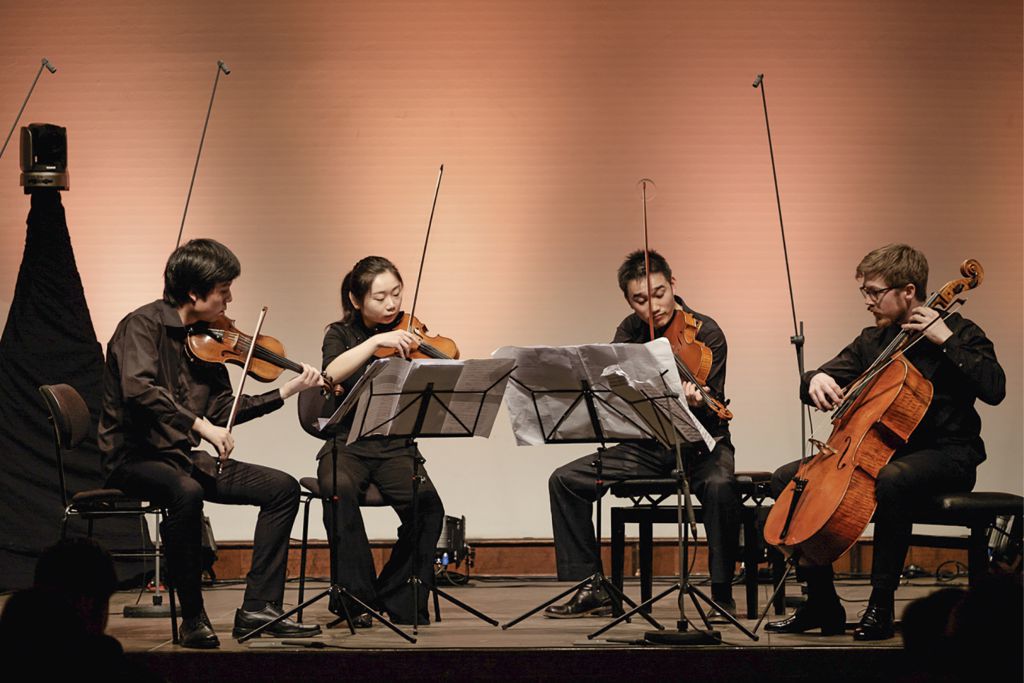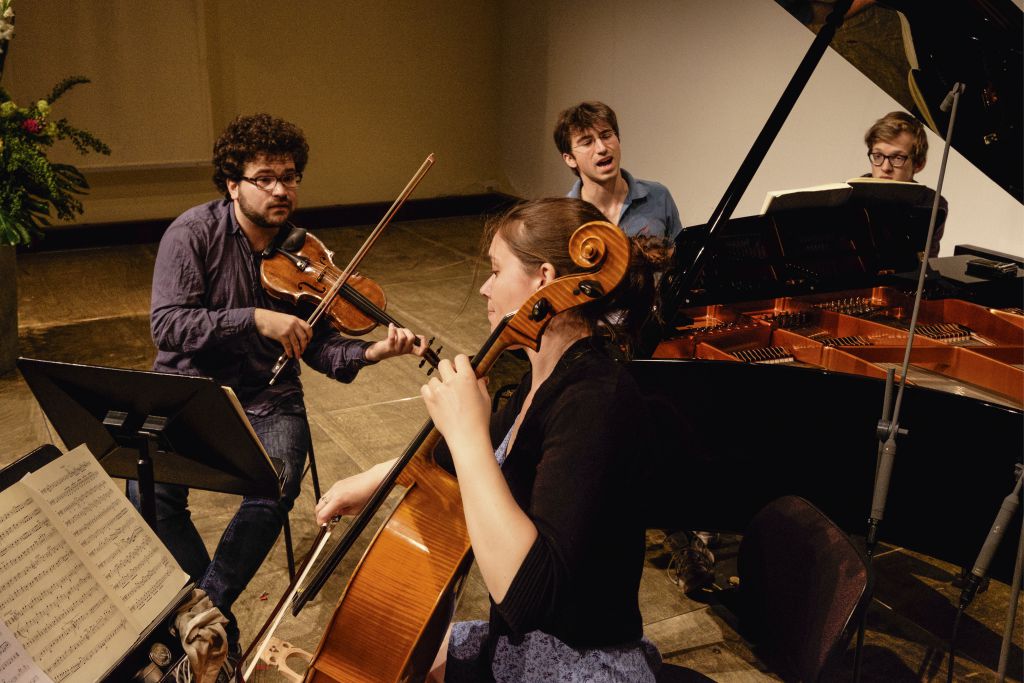A Very Personal Contribution on the Topic of “Togetherness”
An international comparison of institutions will show that chamber music and ensemble work enjoy very high priority in the artistic training offered at the mdw. This wasn’t always the case, however, and it’s in fact the result of deliberate decisions and consistent developmental work.
We view the experience of ensemble making-music at a top international level with responsibility for one’s own contribution as a key factor in the development of independent artistic personalities. And if we look beyond just the musical and interpretive context, we can also regard playing together in an ensemble as a veritable model of successful, mutually inspiring and supportive action and behaviour in all social contexts—chamber music as a principle, so to speak.
My entire professional life as a musician and teacher has been and continues to be shaped by actual chamber music practice and associated reflection: 40 years in a string quartet that’s still active internationally (and still features its original membership) and 30 years teaching chamber music at the mdw and as part of numerous international projects.

Furthermore, the over 20 years that I’ve spent serving in the most varied roles at the University have also led me to think of and experience my work to lead and shape things together with my teams as chamber music in a metaphorical sense.
Chamber music is music-making as part of an ensemble, and the literal meaning of the French word “ensemble” is “together”. An ensemble, therefore, arises as soon as at least two people do something together—and it can, of course, even be as large as an entire orchestra. What I’m getting at here is a general model of collaboration. I’m not talking about the fantastic quality of the incomparable chamber music repertoire, nor am I referring to its historical roots in the “chambers” at aristocratic courts and the parlours of bourgeois homes, and I definitely don’t mean some “miniature format” that belongs in a “chamber” or even a “broom closet”.
The point here is that if we possess an understanding of just what all figures into successful music-making by a group of people in a chamber music setting, then we can also draw analogies to other areas and put these analogies to productive use! So just what phenomena and levels of communication and complexity need to be understood when doing chamber music in order for it to be successful? Allow me to try and provide you with a model:
Let’s assume that all of a given chamber music group’s members are competent on their instruments, want to involve themselves and contribute something, feel responsible for the results, and also have a desire to identify with both the content communicated to the audience and, ultimately, the ensemble itself. Any ensemble working in classical music has a rather clear shared goal: the best-possible interpretation of a piece of music that was imagined and put to paper by a composer—perhaps centuries ago, or perhaps quite recently. This “work”, along with its “text”, embodies a template and instructions for the group’s common effort. So let’s now turn to the processes that play out based on this template. We encounter multiple hermeneutic circles, various levels of communication, interdependencies, and above all complexity. On an initial hermeneutic level, we musicians communicate with the “text”: How do we read it and interpret it? What do we understand and what don’t we? And what might we need to fill in or change? On the basis of this communication with such a template, we—as chamber musicians—need to achieve clarity on all those parameters that are crucial if the point is to “play” together in a way that makes sense: which part has what function when, what shifting “coalitions” are required as the piece progresses, where it’s about the greatest possible homogeneity or clear distinctions, and so on. In this communication with the work, therefore, we already (even before we play) have a communicative challenge situated between the ensemble’s members—who won’t necessarily all read, interpret, or even emotionally grasp the text in the same way right from the beginning. So even when just beginning to explore the possibilities together, we need respect for one another, openness toward viewing things differently, and an ability to resolve situations that involve dissent. And when we actually do begin to play, a second level of communication gives rise to a highly complex network of interdependent relationships between the ensemble’s members. We need to keep in mind here that extremely complex processes have to take place in order for each individual member to bring forth the desired sonic events on their own instrument. In ensemble playing, however, these processes run not independently of one another—i.e., “undisturbed”—but both individually within each member and simultaneously, and they have to come together in a productive way. So when I, as a player, play my part, I’m in communication with the work and/or the composer and following my notion of what the material I’m reading should sound like. But at the same time, I need to be checking whether what I’m doing on my instrument actually does sound like I’d intended and making immediate changes whenever necessary—a lifelong challenge faced by all professionals. It goes without saying that the same thing applies simultaneously to all of an ensemble’s members. And as they’re all busy with their own playing, they also need to be able to use their ears to perceive what the others are playing, reconcile that with their own notions and expectations, and still remain capable of immediate creative reaction to everything that diverges from their own expectations. This multi-level communicative exchange within an ensemble can hence quite justifiably be described as a complex system—for the condition of all participants undergoes continual change as they interact!

As chamber musicians, we have no choice but to learn how to simultaneously give and take, “transmit” and “receive”. And what’s crucial here is the ability to truly listen to each other so that when performing a work, a discourse can arise that makes sense in the moment—be it via “agreement” or in the contrast of “contradiction”. The third communicative level is then communication with the audience: How do we send our “message”, how do we sense whether it’s been perceived, and how do we react to the “response” of those who are listening? This communication, as well, is hence by no means a one-way street—and it runs concurrently with the strands of communication described above.
Last but not least, we have a fourth level of communication —a “meta level” that encompasses those things extrinsic to the musical content that are “transmitted” and “received” both between the ensemble members and between them and the audience. Is what we’re saying with our bodies and our gestures congruent with what we’re telling each other in words and/or through notes? Does the audience perceive what we tell them through our playing as something authentic? Is a “vibe” coming across that’s positive overall, and does our appearance match the content we’re conveying? What impression does the group as a whole make, what effect does it have? In my own life, it’s the case that over the course of time, aiming for a cognitive and intuitive understanding of the significance of these communicative levels and relationships involved in collective and explorative work together with others has become my general underlying approach outside of music-making, as well—in my interactions with students, in our university’s organisational units and project groups, and ultimately as a member of the Rectorate.
Realising this “chamber music principle” requires practice and the energy to repeatedly “try, try again”: respect and esteem, a willingness to allow for differing opinions, a healthy culture of conflict and disagreement, and both loyalty and tolerance require practice every bit as much as do secure intonation, clear articulation, rhythmic stability, and control of one’s sound when making music. To my mind, chamber music embodies the best possible school of life: it’s taught me that the most important form of discipline is self-discipline, and that in an ensemble, we change not our partners but only ever ourselves. So in this spirit, I wish all of us the greatest possible measure of the “chamber music principle” in all of our interactions with each other!

